This is Part 3 of a 3-part series on Making Time for Your Art. Read Part 1, Part 2, and Part 3. This series was also made into a Skillshare class which you can watch here!
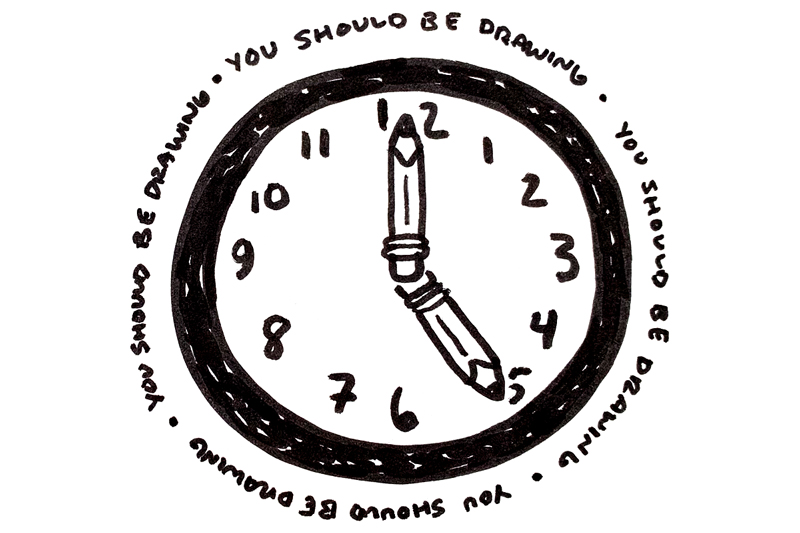
Perhaps you’ve tried some of those time-management techniques. You’ve read countless productivity articles, books on managing your time, and tried again and again to make changes and create a consistent drawing routine. And yet, something snags. Something holds you back. No matter what you try, it just doesn’t work.
You’re not the only one! For years I thought drawing consistently was just a matter of willpower and discipline and would beat myself up for not being able to do it like other artists do. But over the years I’ve learned that’s just not true. There’s so much more to it, and more often than not, the struggle stems from issues much deeper than willpower.
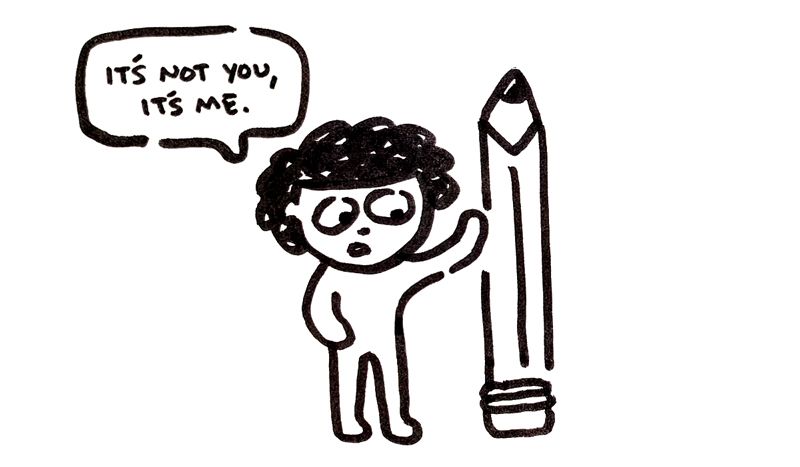
Getting Out of Our Own Way
So often, we think externally, blaming outside circumstances for our problems. We blame our job, our kids, our spouse, anything around us for taking our time and getting in the way of our art. But more often than not, it’s us. WE are holding ourselves back. WE are getting in our own way.
That may sound like terrible news, but it’s actually a good news. Because we can’t change other people or external sources. But we can change ourselves. We can discover and learn what’s inside our minds, and work hard to change our mindset. We can learn to get out of our own way so we can make more art.
Asking the Wrong Questions
If this is where you are, then you’re asking yourself the wrong questions. You don’t need to ask “how do I make more time for my art”. There are deeper more important questions to be asked here.
Instead, we need to be asking: “WHY am I not making time for my art?
Why am I choosing not to draw right now? If you’re choosing not to draw because of deep-down issues, trying to use time-management strategies can become just another method of procrastination. We spend time setting up our desk, organizing our tools, searching for inspiration, looking for new classes to take… anything but the actual drawing.
So WHY? Why are we doing this? For heaven’s sake, why can’t we just sit down and draw?!

Fear
If we follow this thread all the way down, we find the root is fear. No matter what our method of procrastination, no matter what we blame for our lack of time, it all leads to fear. Fear is what holds us back from making our art.
“To the artist, all problems of art appear uniquely personal. Well, that’s understandable enough, given that not many other activities routinely call one’s basic self-worth into question.”
―David Bayles, photographer + author of Art and Fear
So now the question we must ask ourselves has changed again. We can only make time for our art when we figure out the answer to the ultimate deep-down question: What am I afraid of?
Fear is a natural part of the creative process, and we all have similar artistic fears: the fear of not being good enough, fear of failure, fear of mistakes, and fear of what others will think.

Conditioned for Fear
But where does this fear come from? How did we become afraid of a silly thing like making art? It’s a matter of conditioning. This fear and negative thinking is learned thinking.
Through our experiences, we have been conditioned to believe certain things about art. Through teachers, parents, classmates, friends, books, and everything else, we learn what an artist is, who can be an artist, what it means to make art, what is good or bad.
Many of these beliefs are negative, demoralizing, and insanely counter-productive to making art: “I’m terrible at drawing”, “no one likes my art”, “I’ll never be an artist”. Through repetition, we absorb these ideas as our own and these negative thoughts become automatic thoughts, which then develop into our core beliefs about ourselves.
But these thoughts are not facts—they are untrue, unprovable, and unhelpful. They only lead to anxiety, beating ourselves up, creative block, and ultimately, quitting art.
This is all dark and depressing, I know. But there’s good news here too. We learned to think about our art in this way. And if you can learn something, you can also unlearn it. We can learn new ways of thinking about art that will lead us to making more art.
We don’t need more time-management techniques and productivity hacks—we need new core beliefs.
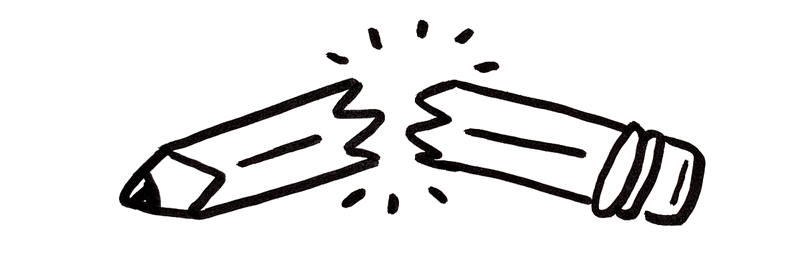
Core Beliefs
Because we learn our beliefs from society and those around us, we tend to share similar core beliefs about what it means to make art and be an artist, especially in the beginning of our artistic journeys. As artists, we either learn to deal with the fear and negative thoughts we’ve absorbed, or fear wins and we quit.
Artists who “don’t have time to draw” blame themselves for being lazy or poor time-managers. But that’s not always true. More often, it’s that they are blocked by their negative thinking. Instead of spending their time and energy on drawing, they spend it ruminating on their core beliefs: “I’m terrible at drawing”, “I should be better by now”, “I wish I could draw as well as so-and-so”, “I’ll never be an artist.”
Instead of creating more art, they create more self-doubt.
It’s these internal blocks that get in the way of making our art. It’s the emotional and mental issues that manifest as self-destructive behaviors, like not making time for our art.
I don’t want that to happen to you. And if it already has, I want to help you unlearn those automatic negative thoughts and get back to drawing. First we have to become aware of which core beliefs we have, and then we can work to replace those negative thoughts with more helpful thoughts.
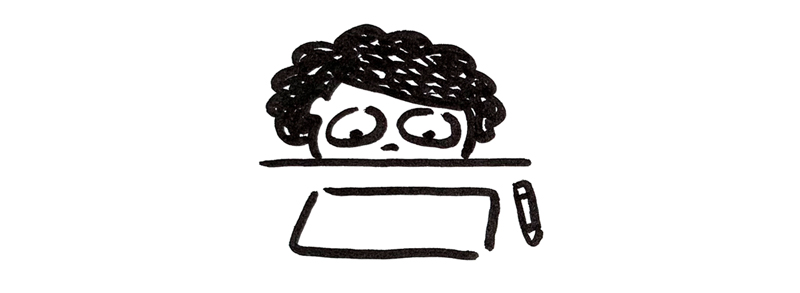
Commonly Held Core Beliefs + Replacement Thoughts
Below are some of the most common core beliefs of artists that lead to fear and self-doubt, as well as a counter thought to help us try to change those automatic thoughts.
This drawing is terrible.
Some drawings I’ll love, and some I won’t—that’s the creative process.
I need to be a best-selling author, award-winning illustrator, gallery-showing painter, etc to be an a “real artist”.
I am an artist if I’m making art. I enjoy making art, and I want to make and share my art regardless of the outcome.
I’m just an imposter/amateur/wannabe artist until someone pays for my artwork.
I can take baby steps towards my goals and enjoy the entire process, not just the end result.
I should be improving my drawing skills faster than I am.
Progress is rarely linear. Improvement is guaranteed if I’m patient and just keep drawing.
I need to be a great artist.
It’s hard to be an artist if I’m pressuring myself to be a great artist. I just want to make art.
I have to draw every single day.
I need restoration and breaks even from things I love.
I need everything I make to be a magnificent piece of art.
There is no perfect. My art will always be imperfect, and that is what makes it unique and special.
I have to draw for hours for it to be “worth it”.
Some days I’ll draw a lot, and some days I won’t. Little bits of drawing add up over time.
If I’m going to draw, it has to be a big, special art project.
Sometimes I’ll have a long-term passionate project, and sometimes I’ll be in between ideas. This is normal, and I can still draw either way.
Making art is a selfish activity.
Making art makes me a better person, more present in my life with others and at peace with myself. I deserve to nurture myself.
I’m not inspired to draw.
I don’t have to wait for inspiration—it will find me when I begin creating.
I wish I could draw like so-and-so.
I am my own, unique artist, and I make my own, unique art.
I have no good ideas—I’m stuck and I’ll always be stuck!
Peaks and valleys are a normal part of the creative process—I will move through this.
I can never draw exactly what’s in my head and that makes me a terrible artist.
I can embrace uncertainty and become comfortable with not knowing what the outcome will be.
Ugh, I just completely messed up this drawing.
The only way to avoid mistakes is to do nothing at all. I can learn from my mistakes and embrace imperfection.
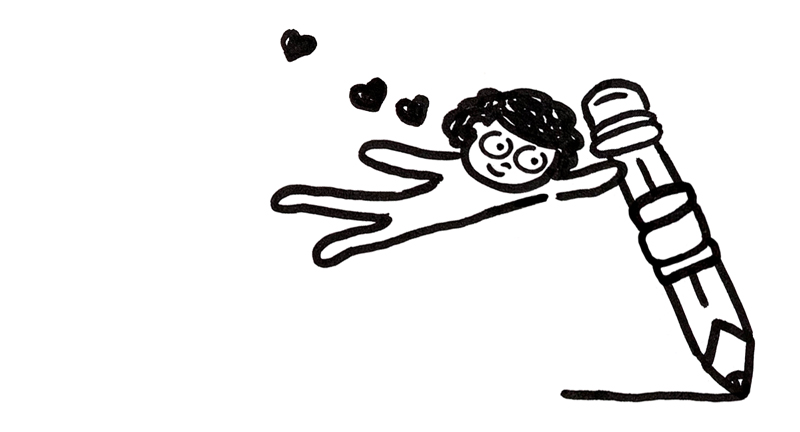
Self-Compassion
There are two common themes in that list of common core beliefs. Our automatic negative thoughts are based in fear and self-doubt. Our replacement thoughts are based in patience and self-compassion.
Our negative thoughts assume they know what the future holds and tend to catastrophize, imagining a situation is worse than it actually is. Our replacement thoughts aim to reflect reality and see the situation as it really is.
Self-compassion allows us to be patient with ourselves, the creative process, and our artistic journey. We’re able to see and accept ourselves as humans with imperfections instead of beating ourselves up for not being perfect-artist-machines.
Treating ourselves with self-compassion leads to accepting our art as it is today. And that acceptance allows us to stop ruminating on our perceived failures, and instead focus on our capacity for growth. It encourages us to keep going and keep drawing, which ultimately leads to way more improvement than bullying ourselves does.
Fear tells us to stop. Self-compassion tells us to keep going.
Being a self-compassionate artist is not being lazy or passive. It’s being kind, patient, and persistent. It’s about being present in the moment of making, instead of obsessing about the future. It’s about being kind and encouraging to ourselves instead of berating and bullying ourselves. It’s about acceptance of our unique way, not the right or wrong way.
It’s about giving ourselves over to the creative process and letting our love of drawing carry us through the peaks and valleys of creating. It’s not about thinking and worrying—it’s about making art.

Fighting Fear with Self-Compassion
Fear and negative thinking is a natural part of artmaking and, unfortunately, it never completely goes away. Even famous, award-winning artists still have fear and self-doubt. Dan Santat, who received the Caldecott Medal (the highest honor in children’s book illustration) in 2015, has said “I constantly worried that I would be discovered as an impostor and that everything would fall apart.”
There’s no way to completely rid ourselves of this fear and self-doubt. But we can learn how to fight it. We can unlearn our unhelpful, automatic negative beliefs.
We can learn how to reframe the negative core beliefs that knock us back into helpful beliefs that propel us forward.
And there’s only one thing that can do all that: self-compassion.
Time-management strategies and productivity hacks are short-term solutions to a long-term problem. The only way to truly make time for artmaking in our life-long artistic journey is to beat back the fear and self-doubt.
We have to stop being so hard on ourselves and try being kind instead.
This is Part 3 of a 3-part series on Making Time for Your Art. Read Part 1, Part 2, and Part 3.
Ready to make more time for your art?
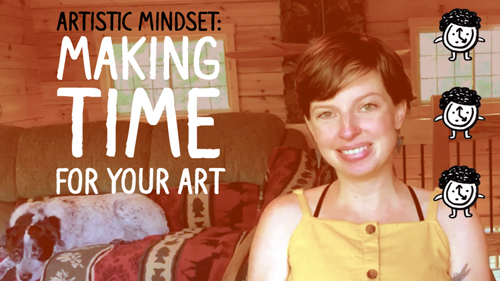
This essay inspired my Skillshare class, Artistic Mindset: Making Time for Your Art. Join us and learn how to prioritize drawing and start drawing consistently!


